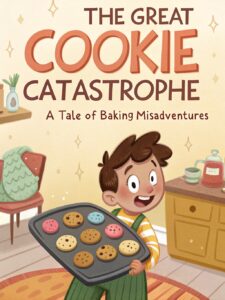
Question More, Action Knowledge.
Remember, at QMAK, we don’t just teach; we empower. We don’t just inform; we inspire. We don’t just question; we act. Become a Gold Member, and let’s unlock your child’s full potential, one question at a time.

Lucas loved helping his mom in the kitchen, especially when they were making chocolate chip cookies. His mom always said that baking was like science – you had to follow the algorithm exactly to get the right result.
“What’s an algorithm again?” Lucas asked one Saturday morning as they prepared to bake cookies for his soccer team’s end-of-season party.
“An algorithm is a set of step-by-step instructions that you follow in a specific order,” Mom explained, pulling out the recipe card. “Like this cookie recipe. It tells us exactly what ingredients to use, how much of each to add, and what order to mix them in.”
Lucas nodded. “So if we follow the algorithm perfectly, we get perfect cookies!”
“Exactly,” Mom smiled. “The ingredients are our inputs, the recipe steps are our algorithm, and delicious cookies are our output.”
Mom needed to take an important phone call, so she left Lucas in charge of starting the cookies. “Just follow the recipe card exactly,” she reminded him. “Don’t skip any steps or change the order.”
Lucas was confident. He’d watched Mom make these cookies dozens of times. How hard could it be?
The recipe card read:
CHOCOLATE CHIP COOKIES
Lucas decided he could make the process more efficient. “I’ll just put everything in one bowl,” he thought. “That way, I won’t have to wash as many dishes.”
He dumped the flour, baking soda, and salt into a large bowl. Then he added the butter, sugars, eggs, and vanilla all at once. It was harder to mix than he expected, and the butter stayed in clumps instead of blending smoothly.
“Maybe I should add the chocolate chips now to help break up the butter,” Lucas reasoned, pouring in the entire bag of chocolate chips. He noticed the bag contained 3 cups instead of the 2 cups called for in the recipe. “More chocolate is always better!” he decided.
The mixture was now a strange, lumpy mess. Parts were too dry, and other parts were too wet. Lucas tried his best to fix it by adding a splash of milk, though the recipe didn’t call for any.
When Mom returned from her call, she found Lucas struggling with a bowl of what looked nothing like cookie dough.
“What happened?” she asked, trying not to laugh at the flour dusting Lucas’s face and hair.
“I don’t know!” Lucas said, frustrated. “I used all the right ingredients, but I wanted to make it easier, so I changed the order a bit.”
Mom took a closer look at the mixture. “I think we’ve had an algorithm malfunction,” she said kindly. “In baking, just like in computer programming or math, the order of operations matters a lot.”
“But why?” Lucas asked. “All the ingredients are in there!”
“Let me show you,” Mom said. She grabbed a fresh mixing bowl and began properly following the recipe algorithm. “When we cream the butter and sugar first, it creates tiny air pockets that make the cookies light and chewy.”
Lucas watched as the butter and sugar transformed into a fluffy, light mixture—nothing like his lumpy concoction.
“Then we add eggs and vanilla,” Mom continued. “They need to mix with the fats before meeting the dry ingredients.”
“Oh, I see,” Lucas said, beginning to understand. “The algorithm isn’t just about having the right ingredients—it’s about the process too.”
“Exactly,” Mom nodded. “And there’s science behind each step. The separate bowl for dry ingredients ensures the baking soda and salt get evenly distributed before meeting the wet ingredients.”
As they finished making the proper batch of cookies together, Lucas noticed how different the dough looked from his first attempt.
“Can we bake my batch too?” Lucas asked. “Just to see what happens?”
Mom agreed, and they scooped both batches onto separate cookie sheets, clearly labeled “Algorithm Followed” and “Algorithm… Not So Much.”
Twenty minutes later, the results were undeniable. The correctly made cookies were golden, chewy in the middle, and perfectly shaped. Lucas’s experimental batch had spread into one giant, weirdly textured cookie-pancake with some parts burnt and others still gooey.
“Wow,” Lucas said, examining both trays. “The algorithm really does matter.”
“It’s the same in many areas of life,” Mom explained. “Computer programmers, doctors, engineers—they all follow algorithms to make sure they get consistent, reliable results.”
“I guess I can’t argue with the evidence,” Lucas laughed, pointing to his cookie disaster. “Next time, I promise to follow the steps in order.”
“That’s the right approach,” Mom smiled. “But you know what? Your cookie catastrophe taught you more about algorithms than a perfect batch ever would have.”
They packed up the good cookies for the soccer party, but saved a few pieces of the cookie-pancake disaster.
“Why are we keeping those?” Lucas asked.
“Sometimes the best way to understand why algorithms work is to see what happens when they don’t,” Mom winked. “Plus, it’ll make a great story to tell your team about your adventures in algorithmic thinking!”
From that day forward, whenever Lucas heard the word “algorithm,” he remembered his great cookie catastrophe—and the important lesson that in baking, coding, and life, the right steps in the right order make all the difference.
The positive messages include:
The elementary reading level is maintained through simple dialogue, concrete examples, and the familiar scenario of baking cookies, making the concept of algorithms accessible and engaging for young readers.

Remember, at QMAK, we don’t just teach; we empower. We don’t just inform; we inspire. We don’t just question; we act. Become a Gold Member, and let’s unlock your child’s full potential, one question at a time.